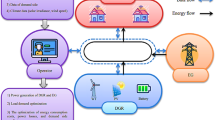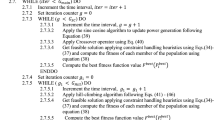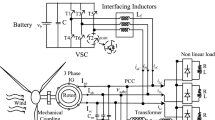Abstract
This paper presents a novel approach to find optimum locations and capacity of flexible alternating current transmission systems (FACTS) devices in a power system using a multi-objective optimization function. Thyristor controlled series compensator (TCSC) and static var compensator (SVC) are the utilized FACTS devices. Our objectives are: active power loss reduction, new introduced FACTS devices cost reduction, voltage deviation reduction, and increase on the robustness of the security margin against voltage collapse. The operational and controlling constraints, as well as load constraints, are considered in the optimum allocation. A multi-objective genetic algorithm (MOGA) is used to approach the Pareto-optimal front (non-dominated) solutions. In addition, the estimated annual load profile has been utilized in a sequential quadratic programming (SQP) optimization sub-problem to the optimum siting and sizing of FACTS devices. IEEE 14-bus Network is selected to validate the performance and effectiveness of the proposed method.
Similar content being viewed by others
Abbreviations
- A :
-
Power plant installation cost in ($/kW)
- B :
-
Refundable investment rate in (percent)
- B SVCj :
-
Susceptance of jth SVC in (pu)
- \({C_{{\rm M var \_SVC}_i }}\) :
-
Cost of one Mvar related to ith SVC in ($/Mvar)
- \({C_{{\rm M var \_TCSC}_j }}\) :
-
Cost of one Mvar related to jth TCSC in ($/Mvar)
- dv i :
-
Maximum voltage violation tolerance (percent)
- DM:
-
Decision Maker
- f1, f2, f3:
-
Problem objective functions
- J L :
-
A set contains all load buses
- K e :
-
Active power cost in ($/kWh)
- nfacts, nplant:
-
Life times of FACTS devices and power plants, respectively in (year)
- \({P_{{\rm loss}_i } (x,u,z)}\) :
-
Active power loss of ith load level from system annual load curve in (kW)
- Ppeak (x, u, z):
-
Peak point power generation in year of study in (kW)
- \({P_{\rm injf}^{\rm TCSC}, Q_{\rm injf}^{\rm TCSC}}\) :
-
Injected active and reactive power at bus f in (pu)
- \({P_{\rm injt}^{\rm TCSC}, Q_{\rm injt}^{\rm TCSC}}\) :
-
Injected active and reactive power at bus t in (pu)
- P0, Q0:
-
Prescribed real and reactive loads at rated (normal) voltage in (pu)
- p f , q f , p t , q t :
-
Constants that reflect the load-voltage characteristics at buses f and t
- P m :
-
Mutation rate \({\in }\) [0, 1]
- \({S_j^{\rm initial}, S_j^{\rm limit}}\) :
-
Demands related to load bus j at initial and limit (critical) states (MVA)
- \({S_{{\rm SVC}_i }}\) :
-
Complex power of ith SVC in (MVA)
- \({S_{{\rm TCSC}_j }}\) :
-
Complex power of jth TCSC in (MVA)
- u :
-
Control variables vector
- v i :
-
Voltage of bus i in (pu)
- \({v_i^{\rm ideal}}\) :
-
Ideal voltage of bus i in (pu)
- x :
-
State variables vector
- X c :
-
Magnitude of X TCSC in (pu)
- X TCSCi :
-
Reactance of ith TCSC in (pu)
- z :
-
Vector containing amount and type of FACTS devices
- χ :
-
Set of feasible solutions
References
Okamoto H, Kurita A, Sekine Y (1995) A method for identification of effective locations of variable impedance apparatus on enhancement of steady-state stability in large-scale power systems. IEEE Trans Power Syst 10: 1401–1407
Sharma NK, Ghosh A, Varma RK (2003) A novel placement strategy for FACTS controllers. IEEE Trans Power Delivery 18: 982–987
Yorino N, EL-Araby EE, Sasaki H, Harada SH (2003) A new formulation for FACTS allocation for security enhancement against voltage collapse. IEEE Trans Power Syst 18: 3–10
Chang CS, Huang JS (1998) Optimal multi-objective SVC planning for voltage stability enhancement. IEE Proc Generation Transm Distrib 145: 203–209
Song SH (2004) Installation and operation of FACTS devices for enhancing steady-state security. Electr Power Syst Res 70: 7–15
Lu Y, Abur A (2002) Static security enhancement via optimal utilization of thyristor controlled series capacitors. IEEE Trans Power Syst 17: 324–329
Gerbex S, Cherkaoui R, Germond AJ (2001) Optimal location of multi-type FACTS devices in a power system by means of genetic algorithms. IEEE Trans Power Syst 16: 537–544
Jurado F, Rodriguez JA (1999) Optimal location of SVC based on systems loadability and contingency analysis. In: 7th IEEE International Conference on Emerging Technologies and Factory Automation
Singh SN, David AK (2000) Congestion management by optimal FACTS device location. In: IEEE International Conference on Electric Utility Deregulation, Restructuring and Power Technologies
Ongsakul W, Bhasaputra P (2002) Optimal power flow with FACTS devices by hybrid TS/SA approach. Electr Power Energy Syst 24: 851–857
Cai LJ, Erlich I, Stamtsis G (2004) Optimal choice and allocation of FACTS devices in deregulated electricity market using genetic algorithms. Power Syst Conf Expos IEEE-PES 1: 201–207
Obadina OO, Berg GJ (1988) Determination of voltage stability limit in multi-machine power systems. IEEE Trans Power Syst 3: 1545–1554
Radu D, Bésanger Y (2006) A multi-objective genetic algorithm approach to optimal allocation of multi-type FACTS devices for power systems security. In: IEEE Power Engineering Society General Meeting
Pareto V (1986) Cours d’Économie Politique. Lausanne, Rouge
Chen YL, Liu CC (1994) Multi-objective VAR planning using the goal-attainment method. IEE Proc Generation Transm Distrib 141: 227–232
Narayana PP, Abdel Moamen MA (2005) Power flow control and solutions with multiple and multi-type FACTS devices. Electr Power Syst Res 74: 341–351
Ambriz-Perez H, Acha E, Fuerte-Esquivel CR (2000) Advanced SVC model for Newton-Raphson load flow and Newton optimal power flow studies. IEEE Trans Power Syst 15: 129–136
Andersson J (2001) Multi-objective optimization in engineering design applications to fluid power systems. Linköping Studies in Science and Technology, Dissertations No. 675
Popov A (2005) Users manual of genetic algorithms for optimization programs for MATLAB
Goldberg DE (1989) Genetic Algorithms in search, optimization, and machine learning. Addison-Wesley, Reading
Fonseca CM, Fleming PJ (1998) Multi-objective optimization and multiple constraint handling with evolutionary algorithms - Part I: a unified formulation. IEEE Trans Syst Man Cybern Part A Syst Humans 28: 26–37
Gill PE, Murray W, Wright M (1981) Practical optimization. Academic Press, London
Kosterev DN, Mittelstadt WA, Mohler RR, Kolodziej WJ (1996) An application study for sizing and rating controlled and conventional series compensation. IEEE Trans Power Delivery 11: 1105–1111
Freris LL, Sasson AM (1968) Investigation of the load flow problem. IEE Proc 115: 1459–1469
Author information
Authors and Affiliations
Corresponding author
Rights and permissions
About this article
Cite this article
Gitizadeh, M. Allocation of multi-type FACTS devices using multi-objective genetic algorithm approach for power system reinforcement. Electr Eng 92, 227–237 (2010). https://doi.org/10.1007/s00202-010-0179-x
Received:
Accepted:
Published:
Issue Date:
DOI: https://doi.org/10.1007/s00202-010-0179-x




